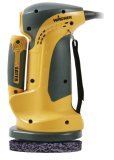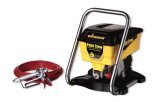Painting exterior siding
Posted by Jim Morris on Sun Jun 11 15:11:28 -0700 2006
I took off a month from work and needed a project, so I decided to repaint the outside of my house. It is an old house with wood siding, the last time I had it painted I asked the contractor to strip the old paint off first as it was peeling badly, I suggested he sandblast it or something first. That was a bad idea, he rented a sandblaster and had never used one and discovered you can't sandblast wood siding (the siding disappears :). Rather than wait for me to come home and tell me about it he decided to go ahead and paint anyway over the old paint. Needless to say that paint job did not last long, you can't paint on top of old peeling paint and get away with it.
So this time I decided I'd do the job myself, after researching the web for how to remove old paint, it was apparent the experts were saying you cannot avoid scraping it off, no mention of sandblasting, but power washers were mentioned, saying they could damage the siding too. Ignoring this I got myself a 2,500 psi gas power washer (Exccel, Home Depot, $299), and indeed found that if you get the head close enough to strip off the paint you also damage the wood, you can get the loosest paint off when the head is about a foot from the wall without damaging the wood, but not much paint comes off, I found the rotating head was most effective.
I rented some 5' scaffolding on casters from Home Depot ($32/week), and this helped a lot to get the top most parts of the house, it is only a single story house so 5' was enough to get to the top.
Stripping old paint
I found the Wagner Paint-Eater (Home depot, $75), and have been using it.
It is gentle enough to not damage the wood, but powerful enough to get most of the loose paint off and feather the edges of the paint that is good. It is not fast though, it takes a while about 1 hour per 25 square feet I'd estimate. Also you go through a lot of the 3M abrasive disks, (Home depot, $15) Probably about 1 every 45 square feet of flaky paint. It lasts better if you don't have to strip down to the wood. The other thing is trying to keep it flush to the surface, it is more effective when held at a slight angle, but this wears the disk down unevenly, and you end up wearing out the disk at the edges long before the center is worn down. However I would still highly recommend this for badly flaking paint on wood siding. You may be able to use a power sander, but I suspect the sanding disks would need to be replaced very often and it would be slower, unless you can afford (or happen to have) a high power compressor (> 10CFM @ 90 PSI) and a high speed air sanding attachment. I haven't tried it, but I suspect the 10,000 RPM with a coarse sanding disk should get through the old paint really fast. The Wagner is about 2,500 RPM I suspect any faster and it would damage the wood.
You must use good eye protection and mask, and I recommend ear protection as well. If you think the paint is lead based then make sure you get a mask that is designed for lead paint removal. My ears rang for a good hour after using this the first time without any ear protection, my eyes kept getting dust in them with regular eye protection (you need one that seals the eyes), and I really got a lung full of dust when I first used it and forgot to put on any kind of mask, so don't make those mistakes!
So I used a combination of power washer to get the loosest stuff off, and a paint scraper to get the next loosest stuff off, then the Wagner paint eater to get the rest off, and feather the edges of the good paint. I also had to fill a lot of cracks and holes with wood filler, and it turns out you are meant to caulk the gaps between the siding boards. (I only caulked the ones which had big gaps).
This left a lot of bare wood and spotty paint areas.
I washed the result down with the power washer to get the saw dust off, making sure it was far enough away to not damage the wood.
Primer
Next I sprayed on a primer as there was bare wood everywhere. I used the Wager paint crew as the spray gun.
This is a nice little airless spray gun, it is very fast, blows through a gallon of paint in under 5 minutes. I was a little surprised by this, the paint said it covered about 350 sq ft per gallon, and I used 3 times that amount. I think the problem was that I had the spray gun too far away from the wall, and had to go over the same area at least twice to get decent coverage, the last part I did I had gotten used to it and I sprayed closer to the wall (about 10 inches) and moved the spray gun slower, this got good coverage on the first pass. I think if I had done this from the start I may have got closer to the 350 sq ft coverage specified.
It is a really good idea to read the directions on the spray gun carefully, and clean it up as per directions, basically the hardest part was cleaning out the gun, I went through a lot of water before the gun ran clear again, but I have read that if you are not careful cleaning it out the next time you use it it simply won't work well.
I covered the entire area with primer in a little over an hour (not counting the fact I had to run down to Home Depot to buy more primer). As I said this thing is fast once you get used to how far to have it from the wall and how fast to move the spray over the surface. I worked from the top down and I noticed in some areas I was getting streaks and drips, another good sign I hadn't figured out quite how to use the gun, I knew I'd have to rub down those areas the next day before spraying the top coat.
Top coat
I was more careful with the top coat, and only used twice as much as recommended, spraying closer and more slowly was a better way to do it, and I only needed to go over once for each siding board, of course now everything was white from the primer and the top coat was white is is hard to remember what has been sprayed and what hasn't. The top coat probably only took an hour and a half, as I had to move the scaffolding around to do the top most parts of the house.
I was surprised to see that the thick latex exterior paint didn't really hide much, all the imperfections of the wood, places where there was old paint which was slightly higher and any little crack in the wood showed through after painting. I was expecting for little imperfections to be covered up, and the fact I had feathered all the old paint down to the wood ought to have been enough.
Trimming
I removed the trimming around the edges and from the windows before painting, this made it easier to remove the old paint. Some of the trimming I cleaned and repaired, some I simply replaced with new wood.
I plan to hand paint the trimming, probably prime it first then nail it back up then paint it some trimming color.
<img src="http://www.assoc-amazon.com/s/noscript?tag=blogwolfmanco-20" alt="" />


I found by meticulously cleaning the paint crew, I avoided the well documented clogging issues. I also got one of the reconditioned units at around $99, so it is significantly cheaper than the next unit up. So I am happy.
I am in the same boat but bought the paint shaver pro and sander vac. Now trying to find out if I should wash all the siding after I strip and sand all the paint off or just blow it with compressed air before painting. Sorry to hear of your painting trouble but I know you learned a lot!
i read spraying does not get the paint onto the wood and if you spray you should use a roller as well and roll it after you spayed it
well its been what 5 years since I did this, and the paint has not peeled off so I guess spraying works :)
The previous "professionals" I had hired to paint it before I think used spray and it peeled off within two years, so I guess it comes down to preparation, most of the old paint had been completely stripped off so I was spraying onto bare wood, and I did use a primer coat.
Nice writeup. I'm trying to decide whether to paint my cedar siding or cover it up with vinyl. I like that you included your learning experiences (how you did it wrong) too. Thanks.